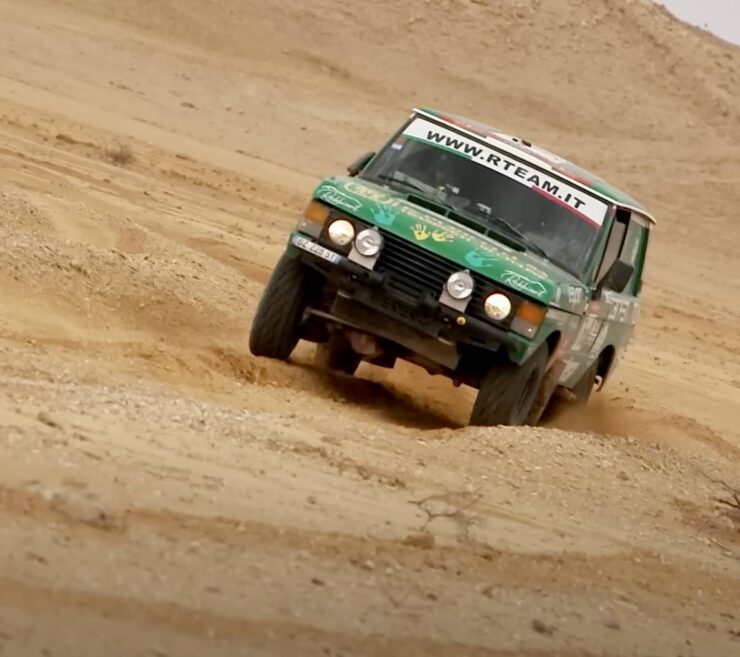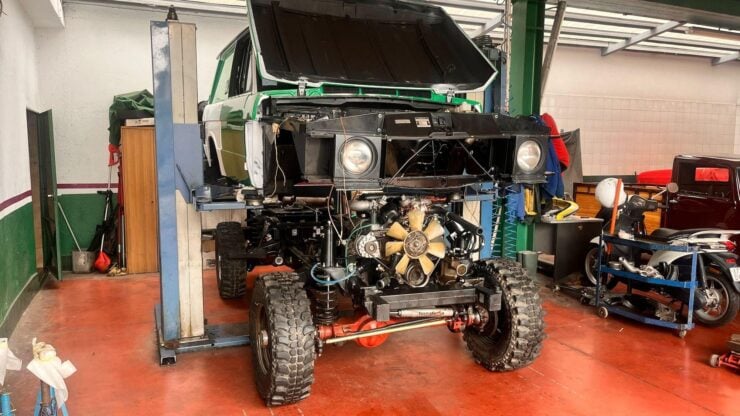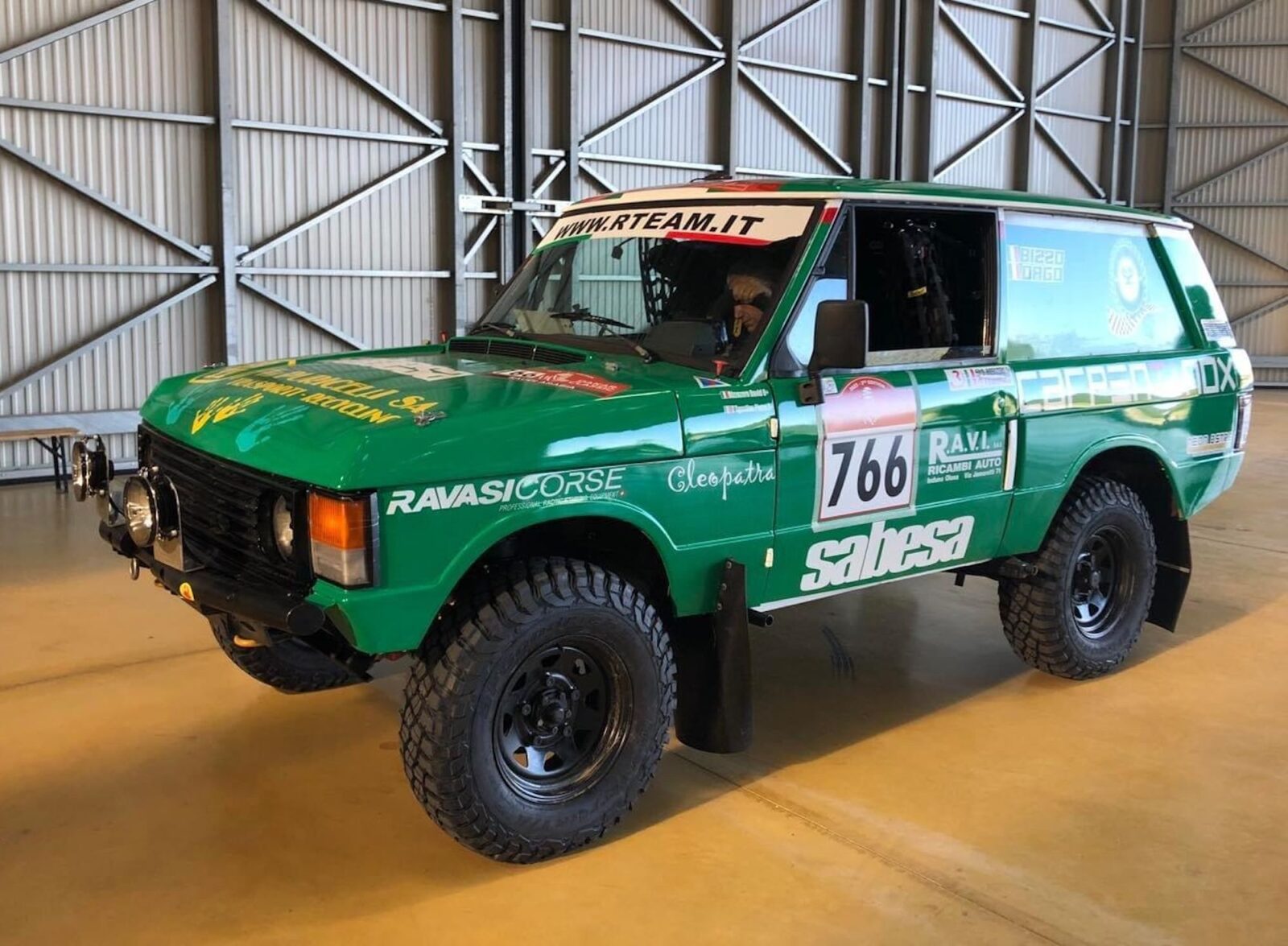This is a 1980 Range Rover V8 that was painstakingly rebuilt into a competitive rally car by Roberto Rettani – an experienced race car builder and FIA ACI Sport technical commissioner. It was built specially for the Dakar Classic 2023, which it then completed.
The Range Rover has a long and proud history in the Dakar Rally, and the Paris Dakar Rally that came before it. In fact, it was a Range Rover driven by the French team of Alain Génestier, Joseph Terbiaut, and Jean Lemordant that won the first ever Dakar in 1979.
Fast Facts – The Range Rover And The Dakar
- The Range Rover debuted in 1970 as “A Car For All Reasons,” it was a luxury SUV back before there was such a thing and it offered spacious accommodation for five passengers, a top speed of over 100 mph, a towing capacity of 3.5 tons, disc brakes on all four wheels, and a permanent four-wheel drive system.
- Charles Spencer “Spen” King led the development team of the Range Rover, he had previously worked at Rolls-Royce, and he brought some of this luxury know-how to bear on the new model. It was considered important that the Range Rover be capable both on road and off, and it was tested extensively.
- Almost 10 years after the Range Rover had debuted a French rally team consisting of Alain Génestier, Joseph Terbiaut, and Jean Lemordant drove a modified two-door Range Rover to an outright win in the first ever Paris Dakar Rally. French drivers René Metge and Bernard Giroux would then win in a Range Rover in 1981.
- The vehicle you see here is a 1980 two-door Range Rover Classic powered by a 3.5 liter Rover V8. It was found in a hen house, restored, and rebuilt into a competitive historic rally car by Roberto Rettani – also an FIA ACI Sport technical commissioner. It competed in the 2023 Dakar Classic, it finished the event, and it’s now being offered for sale out of Switzerland.
The Luxury SUV That Became A Racer
When Charles Spencer “Spen” King and his Rover engineering team were developing the vehicle that would become the Range Rover in the late 1960s, they couldn’t possibly have guessed that just 10 years later the fruit of their labour would take outright victory in the toughest endurance rally on earth – the Paris Dakar Rally.


King never intended for the Range Rover to be a racer, it was designed as arguably the world’s first luxury SUV, and it was marketed at launch as “A Car For All Reasons.” Rover already had the Land Rover in production at this time, an affordable and highly-capable 4×4 that was selling in vast numbers, but it lacked for comfort and was a little too rough around the edges for many.
The new Range Rover was developed on a steel ladder chassis and unusually, it was given coil springs front and back rather than leaf springs. Coils offered better ride quality, and Rover are said to have imported an American Ford Bronco to get a closer look at how Ford had made coil springs work so well in a four-wheel drive application.
Front and rear disc brakes were also fitted, almost unheard of for a 4×4 at the time, and the interior was trimmed in rich carpet, it had large comfortable seats, good sound proofing, and a top speed of over 100 mph thanks to the 3.5 liter Rover V8.
Unusually, the Range Rover was also given a permanent four-wheel drive system rather than the more common option of switching between four wheel drive and rear wheel drive depending on the terrain. Power was sent back through a 4-speed manual gearbox into a dual-range transfer case, and then out to the front and rear live axles.
Rover had focussed on making the new Range Rover genuinely capable off road and this would be something that would play dividends for years, many wealthy people would buy a Range Rover or two as it allowed them to travel in comfort while off road around their estate, or visiting their horses, or out on a pheasant hunt.
The combination of a V8 engine, tough live axles, permanent four wheel drive, and good approach, ramp over, and departure angles made the Range Rover a popular choice for cross-country adventures, and even cross-continental adventures when Cream drummer Ginger Baker drive his Range Rover from England to Nigeria to set up a recording studio in Lagos in the 1970s.


One other use for the British luxury SUV, however unlikely it may seem, was as a race car. An endurance rally car to be more precise. As noted up in the introduction, it would be a Range Rover that won the first ever Paris Dakar Rally in 1979. Another example then won the event again in 1981, perhaps just to prove it wasn’t a fluke.
Back in 1971 two Range Rovers set out, with a Land Rover Series IIA, to become the first vehicles to traverse both American continents north-to-south through the Darién Gap – it took a few months but by 1972 they had succeeded.
The Dakar Classic-Veteran Range Rover Shown Here
The vehicle you see here may look like a rally raid competitor from the 1970s but it was actually built far more recently than that. The current owner of the vehicle, and now seller, is an endurance rally veteran with over 300 entries to his name. He commissioned Roberto Rettani, an experienced race car builder and FIA ACI Sport technical commissioner, to build a Dakar Classic-eligible vehicle to compete in the 2023 event.
The Dakar Classic is a relatively new class in the Dakar Rally, it was founded to allow vintage rally raid vehicles to compete on the modern Dakar Rally course in parallel with the modern cars. It’s proven popular, and the governing body has had to cap entries at 100 per year.
The job laid out before Rettani was challenging, as the Range Rover was found in a significantly worse-for-wear state in a hen house. It was carefully restored, the chassis was strengthened, a Sparco roll bar was fitted, along with Atech sports seats with seatbelts, and the vehicle was completed to the FIA regulations for the Dakar Classic in 2023.
Above Video: This is the official highlights reel of the 2023 Dakar Classic, it does provide some footage of the Range Rover in this article being driven at speed, but only a few seconds here and there.
It competed in the event and finished it, finishing is considered an excellent effort and many never make it to the checkered flag. It’s now being offered for sale with a spare engine and gearbox, a wide array of spare parts, and six all-terrain tires.
If you’d like to read more about it or register to bid you can visit the listing on Car & Classic here. It’s being offered for sale out of Switzerland and it retains its full race livery.














Images courtesy of Car & Classic








